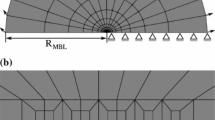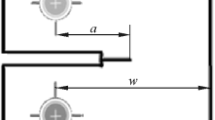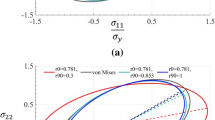Abstract
Crack growth in a solid with plastic anisotropy is modeled by representing the fracture process in terms of a traction-separation law specified on the crack plane, and crack growth resistance curves are calculated numerically. A phenomenological elastic-viscoplastic material model is applied, using one of two different anisotropic yield criteria to account for the plastic anisotropy. The analyses are carried out for conditions of small scale yielding, with mode I loading conditions far from the crack-tip. Different initial orientations of the principal axes relative to the crack plane are considered and it is found that the steady-state fracture toughness is quite sensitive to the type of anisotropy and to the angle of inclination of the principal axes relative to the crack plane.
Similar content being viewed by others
References
Barlat, F., Lege, D.J. and Brem, J.C. (1991). A six-component yield function for anisotropic materials. International Journal of Plasticity 7, 693–712.
Barlat, F., Maeda, Y., Chung, K., Yanagawa, M., Brem, J.C., Hayashida, Y., Lege, D.J., Matsui, K., Murtha, S.J., Hattori, S., Becker, R.C. and Makosey, S. (1997). Yield function development for aluminum alloy sheets. Journal of Mechanics and Physical Solids 45, 1727–1763.
Dafalias, Y.F. (1985a). A missing link in the macroscopic constitutive formulation of large plastic deformation. Plasticity Today, Modelling, Methods and Applications (Edited by A. Sawczuk and G. Bianchi), Elsevier, Amsterdam, 135–151.
Dafalias, Y.F. (1985b). The plastic spin. Transactions of the ASME. Journal of Applied Mechanics 52(4), 865–871.
Hershey, A.V. (1954). The plasticity of an isotropic aggregate of anisotropic face centered cubic crystals. Transactions of the ASME, Journal of Applied Mechanics 21, 241–249.
Hill, R. (1948). A theory of the yielding and plastic flow anisotropic metals. Proceedings of the Royal Society of London A193, 281–297.
Hill, R. (1950). The Mathematical Theory of Plasticity. The Clarendon Press, Oxford.
Hosford, W.F. (1972). A generalized isotropic yield criterion. Transactions of the ASME. Series E. Journal of Applied Mechanics 39, 607–609.
Hosford, W.F. (1992). The plasticity of crystal and polycrystals. Oxford University Press, Oxford.
Hosford, W.F. (1996). On the crystallographic basic of yield criteria. Textures and Microstructures 26–27, 479–493.
Kuroda, M. and Tvergaard, V. (2000). Forming limit diagrams for anisotropic metal sheets with different yield criteria. International Journal of Solids and Structures 37, 5037–5059.
Lee, E.H. (1969). Elastic-plastic deformation at finite strains. Transactions of the ASME. Series E. Journal of Applied Mechanics 36(1), 1–6.
Legarth, B.N. (2003). Debonding of particles in anisotropic materials. International Journal of Mechanical Science 45, 1119–1133.
Legarth, B.N. (2004). Unit cell debonding analyses for arbitrary orientations of plastic anisotropy. Int. J. Solids Structures (to appear).
Legarth, B.N., Tvergaard, V. and Kuroda, M. (2002a). Effects of plastic anisotropy on crack-tip behaviour. International Journal of Fracture 117, 297–312.
Legarth, B.N., Tvergaard, V. and Kuroda, M. (2002b). Crack-tip blunting in an anisotropic material with plastic spin. On-line publication of WCCM V – Fifth World Congress on Computational Mechanics, ISBN 3-9501554-0-6. http://wccm.tuwien.ac.at/
Logan, R.W. and Hosford, W.F. (1980). Upper-bound anisotropic yield locus calculations assuming 111 –pencil glide. International Journal of Mechanical Sciences 22, 419–430.
McMeeking, R.M. (1977). Finite deformation analysis of crack-tip opening in elastic-plastic materials and implications for fracture. Journal of Mechanics and Physics Solids 25, 357–381.
McMeeking, R.M. and Parks, D. (1979). On criteria for J-dominance of crack-tip fields in large scale yielding. Elastic-Plastic Fracture, ASTM STP 668, 175–194.
McMeeking, R.M. and Rice, J.R. (1975). Finite-element formulations for problems of large elastic-plastic deformation. International Journal of Solids and Structures 11, 601–616.
Moen, L.A., Langseth, M. and Hopperdtad, O. (1998). Elastiplastic buckling of anisotropic aluminum, plate elements. Journal of Structural Engineering, 712–719.
Mohammed, I. and Liechti, K.M. (2000). Cohesive zone modeling of crack nucleation at bimaterial corners. Journal of Mechanics and Physics Solids 48, 735–764.
Needleman, A. (1987). A continuum model for void nucleation by inclusion debonding. Journal of Applied Mechanics 54, 525–531.
Needleman, A. and Tvergaard, V. (1983). Crack-tip stress and deformation fields in a solid with vertex on its yield surface. Elastic-Plastic Fracture: Second Symposium, Vol. 1 – Inelastic Crack Analysis, ASTM STP 803, I81-I115.
Rashid, M.M. and Tvergaard, V. (2003). On the path of a crack near a graded interface under large scale yielding. International Journal of Solids and Structures 40, 2819–2831.
Tvergaard, V. (1976). Effect of thickness inhomogeneities in internally pressurized elastic-plastic spherical shells. Journal of Mechanics and Physics Solids 24, 291–304.
Tvergaard, V. (1990). Effect of fibre debonding in a whisker-reinforced metal. Materials and Science Engineering A125, 203–213.
Tvergaard, V. (2001). Resistance curves for mixed mode interface crack growth between dissimilar elastic-plastic solids. Journal of Mechanics and Physics Solids 49, 2689–2703.
Tvergaard, V. and Hutchinson, J.W. (1992). The relation between crack growth resistance and fracture process parameters in elastic-plastic solids. Journal of Mechanics and Physics Solids 40, 1377–1397.
Tvergaard, V. and Hutchinson, J.W. (1993). The influence of plasticity on mixed mode interface toughness. Journal of Mechanics and Physics Solids 41, 1119–1135.
Tvergaard, V. and Hutchinson, J.W. (1994). Effect of T-stress on mode I crack growth resistance in a ductile solid. International Journal of Solids and Structures 31, 823–833.
Yamada, Y. and Hirakawa, H. (1978). Large deformation and instability analysis in metal forming process. Applications of Numerical Methods to Forming Processes, ASME, AMD 28, 27–38.
Yamada, Y. and Sasaki, M. (1995). Elastic-plastic large deformation analysis program and lamina compression test. International Journal of Mechanics, 691–707.
Author information
Authors and Affiliations
Rights and permissions
About this article
Cite this article
Tvergaard, V., Legarth, B.N. Effect of plastic anisotropy on crack growth resistance under mode 1 loading. International Journal of Fracture 130, 411–425 (2004). https://doi.org/10.1023/B:FRAC.0000049498.15818.33
Issue Date:
DOI: https://doi.org/10.1023/B:FRAC.0000049498.15818.33




